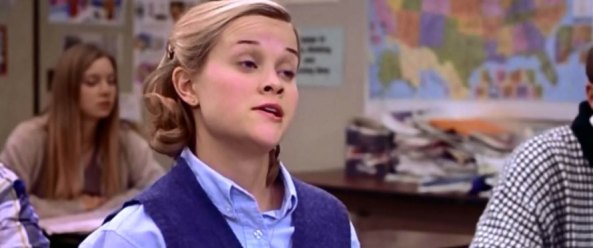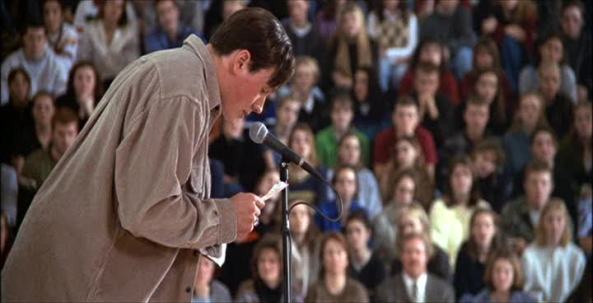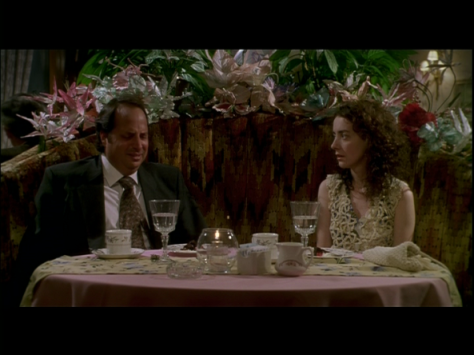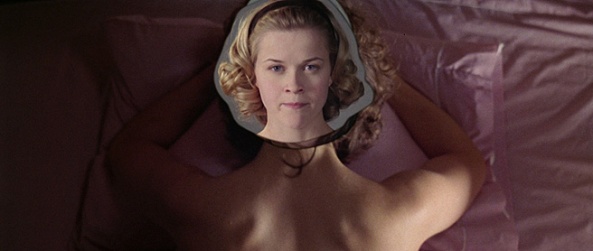Of all the depressing, pitiable people in “Happiness,” Todd Solondz’s absolutely disturbed black comedy of suburbia, sex, sickness and sadness, the one I feel the worst for is Trish Maplewood.
Wait, which one is Trish (Cynthia Stevenson)? Is she the sister caught in arrested development, the smug, narcissistic poet who secretly suspects she’s talentless or the woman who described a case of rape and murder over an ice cream sundae?
No, Trish is perhaps the only one in “Happiness” without a crippling sex addiction, perversion, loneliness or self-destructive tendency. Her fatal flaw seems to be that she’s too normal, and worse yet that she managed to fall in love with a monstrous creep.
Trish is like the control group in Solondz’s examination of twisted individuals, the least interesting and noticeable figure of the bunch. We arguably identify with her the least because there’s the least to latch onto. Part of what makes “Happiness” so affecting though is that there’s a little bit of something we can relate to in each of the other dark characters because each has a little bit of normalcy.
She’s not unlike Jim McAllister’s wife Diane (Molly Hagan) in Alexander Payne’s “Election,” a simple house wife who exists in the background. We learn some about her, her desires, her sex drive and what she loves about her fairly awful husband. But for all intensive purposes, she’s nobody.
Released a year apart in 1998 and 1999, “Happiness” and “Election” are both complex satires of those nobodies, simple people in ordinary middle American neighborhoods, people who in their own strange ways feel universally relatable. For those who have levied claims that Payne is mocking and trivializing the simpleton schmucks in his films, that’s absolutely accurate, and it feels no less honest.
These films were also the breakout second features of now indie darlings. Solondz has dipped deeper into his polarizing neuroses and styles while Payne’s films have deepened into more serious and Oscar friendly territory. Solondz’s darkly ironic and bleak tone is miles apart from Payne’s perky, blissfully unaware one, but they trade in similar themes of loneliness, ethics and behavior as seen through the lens of the plain, unglamorous folk often in the background of other films.
This GIF of Philip Seymour Hoffman says it all. A coworker asks him about the “game” last night just as Hoffman’s Allen has finished whispering sexual obscenities over the phone to his sexy neighbor Helen (Lara Flynn Boyle), and he turns on the pleasantries in a moment of pure perfection (it’s good enough to make you sob again at the thought of his passing).
Then of course there’s this wonderful shot from “Election” of the cluelessly lovable jock Paul Metzler (Chris Klein) lumbering over a microphone way too short for him, with peering, judging eyes scrutinizing him in the hazy background. His posture most of all in this shot suggests something more complex and troubled than the pretty face before us.
For Payne, we’re occasionally given a peek behind the curtain to the dark, flawed natures of these ordinary individuals, whereas Solondz has us waiting backstage during the dark behind the scenes, only occasionally stepping out into the spotlight for a moment of plainness.
Both films however share visual styles and techniques that elevate the material at hand. “Happiness” has the most impressive and stand-offish aesthetic, utilizing gaudy colors (like in the film’s fantastic opening scene) and broad, open, off kilter framing that drives a wedge and distance between all the characters. It’s all tonally out of place, and Solondz really hits a heartbreaking stride when he plays up the cornier, more maudlin aspects of his presentation in order to create a queasy sensation. The best example comes early when some cheesy LifeTime movie strings play over the top of a touching father/son conversation. The only problem is that their conversation involves the father offering to demonstrate to his son how to masturbate.
Payne’s visual style is a bit more understated. He employs some big low angles and quickly scurrying camera movements that underscore the more cartoony, comical aspects of it all. The famous freeze frame of the film’s star Tracy Flick (Reese Witherspoon) so easily gives us an image to loathe and laugh at, despite it being completely uncharacteristic of the rest of the film’s look. The same happens when Mr. McAllister (Matthew Broderick) is having sex with his wife, and he fantasizes about other faces super-imposed over the top. What makes it so odd, hilarious and unexpected is that Payne does it with a floating cutout of Tracy’s head, not a full representation of her. It’s an example of some of the goofy double takes Payne puts us through, be it when Paul is suddenly getting a blow job or when Tammy is discussing how long it will take before asparagus causes your pee to smell funny.
Above all though is a respect for these characters in each film. No one is made into a one-dimensional villain, be it Allen, Tracy, Bill Maplewood or Jim McAllister. We find them to be repugnant, grating individuals each in their own way, but they feel real and never completely like bad people. Like the heart of America where these films take place, it’s the strange middle ground where each film’s truth and comedy lies.





1 thought on “Side by Side: Happiness and Election”